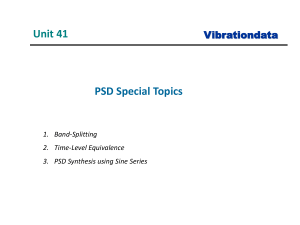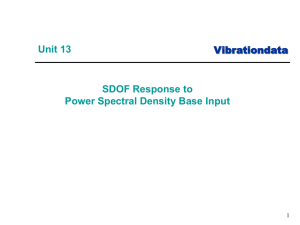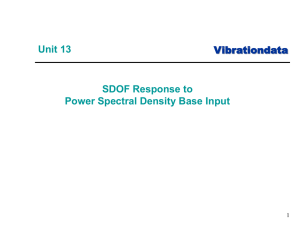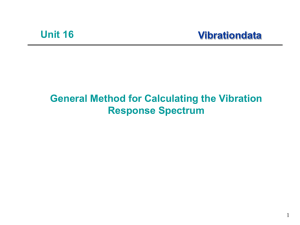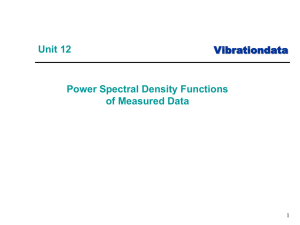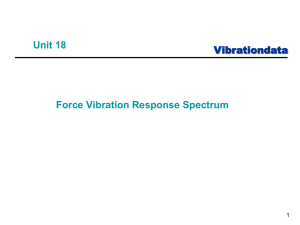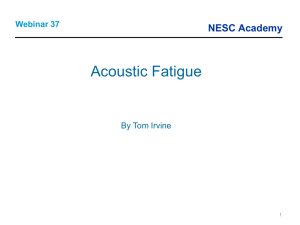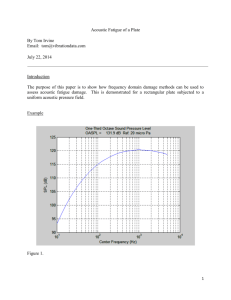Webinar_11_PSD - NESC Academy Online
advertisement
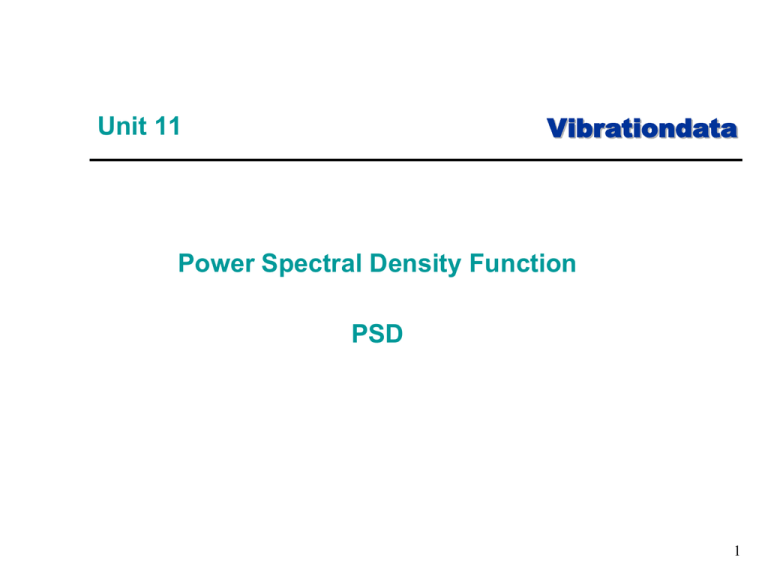
Vibrationdata Unit 11 Power Spectral Density Function PSD 1 PSD Introduction Vibrationdata • A Fourier transform by itself is a poor format for representing random vibration because the Fourier magnitude depends on the number of spectral lines, as shown in previous units • The power spectral density function, which can be calculated from a Fourier transform, overcomes this limitation • Note that the power spectral density function represents the magnitude, but it discards the phase angle • The magnitude is typically represented as G2/Hz • The G is actually GRMS 2 Sample PSD Test Specification 0.1 Vibrationdata Overall Level = 6.0 grms 2 0.04 g / Hz -3 dB / octave 2 PSD ( g / Hz ) +3 dB / octave 0.01 0.001 20 80 350 2000 FREQUENCY (Hz) 3 Calculate Final Breakpoint G^2/Hz 0.1 Overall Level = 6.0 grms 2 0.04 g / Hz -3 dB / octave +3 dB / octave Number of octaves between two frequencies 2 PSD ( g / Hz ) Vibrationdata n 0.01 ln (f 2 / f1 ) ln (2) Number of octaves from 350 to 2000 Hz = 2.51 0.001 20 80 350 2000 FREQUENCY (Hz) The level change from 350 to 2000 Hz = -3 dB/oct x 2.51 oct = -7.53 dB For G^2/Hz calculations: dB 10 log A / B The final breakpoint is: (2000 Hz, 0.007 G^2/Hz) 4 Overall Level Calculation Vibrationdata Note that the PSD specification is in log-log format. Divide the PSD into segments. The equation for each segment is y1 n y (f ) f f n 1 The starting coordinate is (f1, y1) 5 Vibrationdata Overall Level Calculation (cont) The exponent n is a real number which represents the slope. The slope between two coordinates y log 2 y1 n f2 log f1 The area a1 under segment 1 is f y a1 2 1 f n df f1 n f1 6 Overall Level Calculation (cont) Vibrationdata There are two cases depending on the exponent n. a1 y1 1 f n 1 f n 1 , for n 1 1 f n n 1 2 1 f 2 y1f1 ln , for n 1 f1 7 Overall Level Calculation (cont) Vibrationdata Finally, substitute the individual area values in the summation formula. The overall level L is the “square-root-of-the-sum-of-the-squares.” L m ai i 1 where m is the total number of segments 8 Vibrationdata dB Formulas dB difference between two levels If A & B are in units of G2/Hz, A dB 10 log B If C & D are in units of G or GRMS, C dB 20 log D 9 dB Formula Examples Vibrationdata Add 6 dB to a PSD The overall GRMS level doubles The G^2/Hz values quadruple Subtract 6 dB from a PSD The overall GRMS level decreases by one-half The G^2/Hz values decrease by one-fourth 10 PSD Calculation Methods Vibrationdata Power spectral density functions may be calculated via three methods: 1. Measuring the RMS value of the amplitude in successive frequency bands, where the signal in each band has been bandpass filtered 2. Taking the Fourier transform of the autocorrelation function. This is the Wierner-Khintchine approach. 3. Taking the limit of the Fourier transform X(f) times its complex conjugate divided by its period T as the period approaches infinity. 11 PSD Calculation Method 3 Vibrationdata The textbook double-sided power spectral density function XPSD(f) is lim X(f)X * (f) XPSD (f) T T The Fourier transform X(f) has a dimension of [amplitude-time] is double-sided 12 PSD Calculation Method 3, Alternate Vibrationdata Let be the one-sided power spectral density function. lim G(f) G * (f) ˆ X (f) PSD Δf Δf 0 The Fourier transform G(f) has a dimension of [amplitude] is one-sided ( must also convert from peak to rms by dividing by 2 ) 13 Recall Sampling Formula Vibrationdata The total period of the signal is T = Nt where N is number of samples in the time function and in the Fourier transform T is the record length of the time function t is the time sample separation 14 More Sampling Formulas Vibrationdata Consider a sine wave with a frequency such that one period is equal to the record length. This frequency is thus the smallest sine wave frequency which can be resolved. This frequency f is the inverse of the record length. f = 1/T This frequency is also the frequency increment for the Fourier transform. The f value is fixed for Fourier transform calculations. A wider f may be used for PSD calculations, however, by dividing the data into shorter segments 15 Statistical Degrees of Freedom Vibrationdata • The f value is linked to the number of degrees of freedom • The reliability of the power spectral density data is proportional to the degrees of freedom • The greater the f, the greater the reliability 16 Statistical Degrees of Freedom (Continued) Vibrationdata The statistical degree of freedom parameter is defined follows: dof = 2BT where dof is the number of statistical degrees of freedom B is the bandwidth of an ideal rectangular filter Note that the bandwidth B equals f, assuming an ideal rectangular filter The BT product is unity, which is equal to 2 statistical degrees of freedom from the definition in equation 17 Trade-offs Vibrationdata • Again, a given time history has 2 statistical degrees of freedom • The breakthrough is that a given time history record can be subdivided into small records, each yielding 2 degrees of freedom • The total degrees of freedom value is then equal to twice the number of individual records • The penalty, however, is that the frequency resolution widens as the record is subdivided • Narrow peaks could thus become smeared as the resolution is widened 18 Example: 4096 samples taken over 16 seconds, rectangular filter. Vibrationdata Period of Each Record Ti (sec) Frequency Resolution Bi=1/Ti (Hz) dof per Record =2Bi TI Total dof 1 Number of Time Samples per Record 4096 16 0.0625 2 2 2 2048 8 0.125 2 4 4 1024 4 0.25 2 8 8 512 2 0.5 2 16 16 256 1 1 2 32 32 128 0.5 2 2 64 64 64 0.25 4 2 128 Number of Records NR 19 Summary Vibrationdata • Break time history into individual segment to increase degrees-of-freedom • Apply Hanning Window to individual time segments to prevent leakage error • But Hanning Window has trade-off of reducing degrees-of-freedom because it removes data • Thus, overlap segments • Nearly 90% of the degrees-of-freedom are recovered with a 50% overlap 20 Original Sequence Vibrationdata Segments, Hanning Window, Non-overlapped 21 Original Sequence Vibrationdata Segments, Hanning Window, 50% Overlap 22
